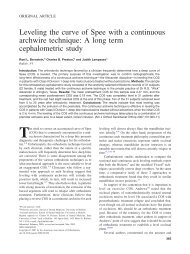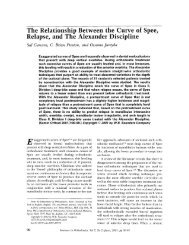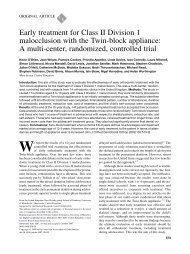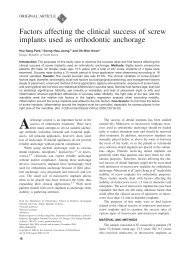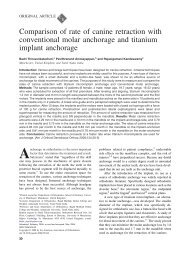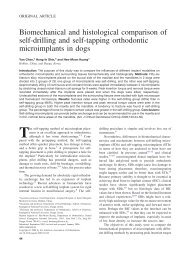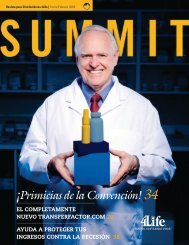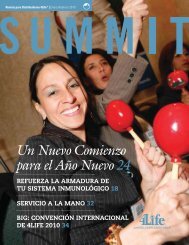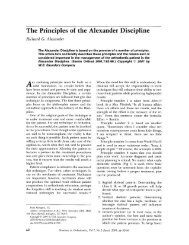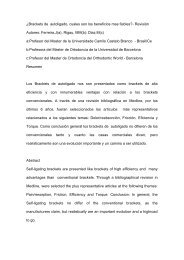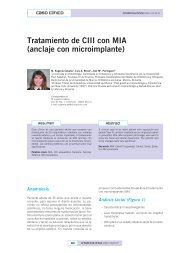Clinical use of miniscrew implants as orthodontic anchorage ...
Clinical use of miniscrew implants as orthodontic anchorage ...
Clinical use of miniscrew implants as orthodontic anchorage ...
You also want an ePaper? Increase the reach of your titles
YUMPU automatically turns print PDFs into web optimized ePapers that Google loves.
ORIGINAL ARTICLE<br />
<strong>Clinical</strong> <strong>use</strong> <strong>of</strong> <strong>miniscrew</strong> <strong>implants</strong><br />
<strong>as</strong> <strong>orthodontic</strong> <strong>anchorage</strong>: Success rates<br />
and postoperative discomfort<br />
Shingo Kuroda, a Y<strong>as</strong>uyo Sugawara, a Toru Deguchi, a Hee-Moon Kyung, b and Teruko Takano-Yamamoto c<br />
Okayama, Japan, and Daegu, South Korea<br />
Introduction: In this study, we evaluated the clinical <strong>use</strong>fulness <strong>of</strong> <strong>miniscrew</strong>s <strong>as</strong> <strong>orthodontic</strong> <strong>anchorage</strong>. We<br />
examined their success rates, analyzed factors <strong>as</strong>sociated with their stability, and evaluated patients’<br />
postoperative pain and discomfort with a retrospective questionnaire. Methods: Seventy-five patients, 116<br />
titanium screws <strong>of</strong> 2 types, and 38 miniplates were retrospectively examined. Each patient w<strong>as</strong> given a<br />
questionnaire that included a visual analog scale to indicate discomfort after implantation. Results: The<br />
success rate for each type <strong>of</strong> implant w<strong>as</strong> greater than 80%. The analysis <strong>of</strong> 79 <strong>miniscrew</strong>s with a 1.3-mm<br />
diameter showed no significant correlations between success rate and these variables: age, sex, mandibular<br />
plane angle, anteroposterior jaw-b<strong>as</strong>e relationship, control <strong>of</strong> periodontitis, temporomandibular disorder<br />
symptoms, loading, and screw length. Most patients receiving titanium screws or miniplates with mucoperiosteal-flap<br />
surgery reported pain, but half <strong>of</strong> the patients receiving <strong>miniscrew</strong>s without flap surgery did not<br />
report feeling pain at any time after placement. In addition, patients with <strong>miniscrew</strong>s reported minimal<br />
discomfort due to swelling, speech difficulty, and difficulty in chewing. Conclusions: Miniscrews placed<br />
without flap surgery have high success rates with less pain and discomfort after surgery than <strong>miniscrew</strong>s<br />
placed with flap surgery or miniplates placed with either procedure. (Am J Orthod Dent<strong>of</strong>acial Orthop 2007;<br />
131:9-15)<br />
Anchorage control in edgewise treatment is an<br />
important factor affecting treatment results. In<br />
the traditional approach, appliances such <strong>as</strong><br />
headgear and intraoral el<strong>as</strong>tics are <strong>use</strong>d to reinforce<br />
<strong>anchorage</strong>, but it is difficult to obtain stationary <strong>anchorage</strong><br />
even when the patients show excellent cooperation.<br />
1-4 5-7<br />
In the p<strong>as</strong>t, dental <strong>implants</strong>, miniplates, and titanium<br />
screws 8-10 were <strong>use</strong>d <strong>as</strong> skeletal <strong>anchorage</strong>. These<br />
materials can provide stationary <strong>anchorage</strong> for various<br />
tooth movements without requiring patient cooperation.<br />
Dental <strong>implants</strong> and miniplates have high success<br />
rates and are strong enough to resist the reciprocal<br />
1-7<br />
forces <strong>of</strong> various <strong>orthodontic</strong> tooth movements.<br />
However, implantation <strong>of</strong> these devices requires com-<br />
aAssistant pr<strong>of</strong>essor, Department <strong>of</strong> Orthodontics and Dent<strong>of</strong>acial Orthopedics,<br />
Graduate School <strong>of</strong> Medicine and Dentistry, Okayama University, Okayama,<br />
Japan.<br />
bPr<strong>of</strong>essor, Department <strong>of</strong> Orthodontics, School <strong>of</strong> Dentistry, Kyungpook<br />
National University, Daegu, South Korea.<br />
cPr<strong>of</strong>essor and chair, Department <strong>of</strong> Orthodontics and Dent<strong>of</strong>acial Orthopedics,<br />
Graduate School <strong>of</strong> Medicine and Dentistry, Okayama University, Okayama,<br />
Japan.<br />
Reprint requests to: Dr Teruko Takano-Yamamoto, Department <strong>of</strong> Orthodontics<br />
and Dent<strong>of</strong>acial Orthopedics, Graduate School <strong>of</strong> Medicine and Dentistry,<br />
Okayama University, 2-5-1 Shikata-Cho, Okayama 700-8525, Japan; e-mail,<br />
t_yamamo@md.okayama-u.ac.jp.<br />
Submitted, October 2004; revised and accepted, February 2005.<br />
0889-5406/$32.00<br />
Copyright © 2007 by the American Association <strong>of</strong> Orthodontists.<br />
doi:10.1016/j.ajodo.2005.02.032<br />
plicated surgery, leading to higher medical costs. In<br />
contr<strong>as</strong>t, titanium screws have advantages: the ability to<br />
provide the same rigid <strong>anchorage</strong> against <strong>orthodontic</strong><br />
loads <strong>as</strong> dental <strong>implants</strong> or miniplates, minimal anatomic<br />
limitations on placement, lower medical costs,<br />
8-10<br />
and simpler placements with less traumatic surgery.<br />
Recently, <strong>miniscrew</strong>s less than 1.5 mm in diameter<br />
11-13<br />
have been <strong>use</strong>d for various <strong>orthodontic</strong> indications.<br />
However, few human studies have examined factors<br />
<strong>as</strong>sociated with the stability <strong>of</strong> titanium screws <strong>use</strong>d for<br />
<strong>orthodontic</strong> <strong>anchorage</strong>. 14,15 In addition, there have been<br />
few human reports about the success rates <strong>of</strong> <strong>miniscrew</strong>s.<br />
Fear <strong>of</strong> pain is a problem beca<strong>use</strong> it contributes to<br />
patients’ avoidance <strong>of</strong> <strong>orthodontic</strong> treatment.<br />
16 Most<br />
patients report pain and discomfort during <strong>orthodontic</strong><br />
treatment. 17-21 Beca<strong>use</strong> <strong>of</strong> the surgical procedure, many<br />
patients are also concerned about pain and discomfort<br />
after implantation. For patients, an appealing feature <strong>of</strong><br />
skeletal <strong>anchorage</strong> might be the minimal surgical inv<strong>as</strong>ion.<br />
However, there are few reports about postoperative<br />
pain and discomfort after implantation <strong>of</strong> <strong>orthodontic</strong><br />
<strong>anchorage</strong>.<br />
Our aim in this study w<strong>as</strong> to evaluate the clinical<br />
<strong>use</strong>fulness <strong>of</strong> <strong>miniscrew</strong>s <strong>as</strong> <strong>orthodontic</strong> <strong>anchorage</strong>. We<br />
examined their success rates, analyzed the factors<br />
9
10 Kuroda et al<br />
Fig 1. Implants <strong>use</strong>d <strong>as</strong> <strong>orthodontic</strong> <strong>anchorage</strong>. A, Type A titanium screws, 2.0-mm in diameter and<br />
7-mm in length, and 2.3-mm in diameter and 11-mm in length; B, type B titanium screw, 1.3-mm in<br />
diameter and 8-mm in length; C, miniplate with screws, 2 mm in diameter and 5 mm in length;<br />
D, clinical <strong>use</strong> <strong>of</strong> type B screw.<br />
<strong>as</strong>sociated with their stability, and evaluated patients’<br />
postoperative pain and discomfort ca<strong>use</strong>d by implantation<br />
with a retrospective questionnaire.<br />
MATERIAL AND METHODS<br />
Our subjects were 75 patients with malocclusions<br />
(12 male, 63 female; mean age, 21.8 years; SD, 8.2<br />
years) who had surgery at Okayama University Hospital<br />
to place a skeletal <strong>anchorage</strong> for edgewise treatment<br />
between November 2000 and March 2004. Before<br />
implantation, the advantages and disadvantages were<br />
explained to each patient and his or her parents when an<br />
implant anchor w<strong>as</strong> considered desirable for <strong>orthodontic</strong><br />
treatment. Two kinds <strong>of</strong> titanium screws with<br />
different diameters and lengths were <strong>use</strong>d: type A<br />
(Inter-maxillary fixation screw, Keisei Medical Industrial,<br />
Tokyo, Japan): diameter, 2.0 or 2.3 mm; length, 7<br />
or 11 mm; screw head, 3 mm; and type B (AbsoAnchor,<br />
American Journal <strong>of</strong> Orthodontics and Dent<strong>of</strong>acial Orthopedics<br />
January 2007<br />
Dentos, Daegu, Korea): diameter, 1.3 mm; length, 6, 7,<br />
8, 10, and 12 mm; screw head, 3 mm. Miniplates with<br />
2 or 3 screws (SAS system [Dentsply-Sankin, Tokyo,<br />
Japan]; diameter, 2.0 mm; length, 5 mm) were also<br />
<strong>use</strong>d for skeletal <strong>anchorage</strong> (Fig 1).<br />
The miniplates were placed under local anesthesia<br />
by senior oral surgeons at the Department <strong>of</strong> Oral and<br />
Maxill<strong>of</strong>acial Surgery, Okayama University Hospital in<br />
Japan. First, a mucoperiosteal incision w<strong>as</strong> made at<br />
the site where emergence <strong>of</strong> the anchor w<strong>as</strong> desirable.<br />
The mucoperiosteal flap w<strong>as</strong> then reflected to<br />
expose the cortical bone. The miniplate w<strong>as</strong> adjusted<br />
to fit the contour <strong>of</strong> the bone surface, and screw holes<br />
were made by using a 1.5-mm twist drill with continuous<br />
normal saline-solution irrigation. The plates were<br />
then fixed by 2 or 3 monocortical <strong>miniscrew</strong>s by using<br />
a self-tapping method. The head <strong>of</strong> miniplate w<strong>as</strong><br />
exposed to the oral cavity through the incision. The
American Journal <strong>of</strong> Orthodontics and Dent<strong>of</strong>acial Orthopedics<br />
Volume 131, Number 1<br />
mucoperiosteal incision w<strong>as</strong> sutured with 3-0 silk. The<br />
sutures were removed 7 to 10 days after surgery.<br />
Type A screws were placed by the same senior oral<br />
surgeons in the same manner <strong>as</strong> miniplates. Under local<br />
anesthesia, the mucoperiosteal flap w<strong>as</strong> reflected to<br />
expose the cortical bone. The screw holes were made<br />
by using a 1.6-mm twist drill with continuous normal<br />
saline-solution irrigation. The screw head w<strong>as</strong> adjusted<br />
at le<strong>as</strong>t 2 mm above the mucosa and exposed to the oral<br />
cavity through the incision. The mucoperiosteal incision<br />
w<strong>as</strong> sutured, and the sutures were removed 7 to 10<br />
days after surgery.<br />
Type B screws were placed under local anesthesia<br />
by an orthodontist (S.K.). No mucoperiosteal incision<br />
or flap w<strong>as</strong> made, and the screw holes were made by a<br />
1.0-mm round bar and twist drill at 500 rpm with<br />
continuous normal saline-solution irrigation. The<br />
1.3-mm screws were then placed through the attached<br />
gingiva by using a self-tapping method with continuous<br />
irrigation. The screw w<strong>as</strong> inserted 5 or 6 mm into the<br />
alveolar bone, and the screw head w<strong>as</strong> adjusted at le<strong>as</strong>t<br />
2 mm above the mucosa. (Fig 1D). After the placement<br />
surgery, the positions <strong>of</strong> the screws were checked with<br />
dental radiographs.<br />
The <strong>orthodontic</strong> appliances were not adjusted at the<br />
implantation appointment. Loading <strong>of</strong> the miniplates<br />
and the type A screws began 4 to 12 weeks after<br />
placement surgery, where<strong>as</strong> that <strong>of</strong> the type B screws<br />
began 0 to 12 weeks after surgery. The <strong>orthodontic</strong> load<br />
w<strong>as</strong> applied by el<strong>as</strong>tic chain or nickel-titanium closing<br />
coil springs, estimated between 50 and 200 g. If the<br />
<strong>orthodontic</strong> force could be applied to the skeletal<br />
<strong>anchorage</strong> for 1 year (or until completion <strong>of</strong> the<br />
<strong>orthodontic</strong> treatment), we recorded the skeletal <strong>anchorage</strong><br />
<strong>as</strong> a success.<br />
Each patient received a retrospective questionnaire<br />
with a 100-point visual analog scale (VAS) concerning<br />
discomfort ca<strong>use</strong>d by the implant surgery, not by the<br />
adjustment <strong>of</strong> the <strong>orthodontic</strong> appliances. They were<br />
<strong>as</strong>ked whether they experienced any <strong>of</strong> the following<br />
forms <strong>of</strong> discomfort after implantation: pain (time<br />
course and intensity), swelling, difficulty in chewing,<br />
speech difficulty, and difficulty in toothbrushing. The<br />
VAS w<strong>as</strong> a 100-mm line with anchors at each end <strong>of</strong><br />
the line that read “no pain (or discomfort)” (0 mm) and<br />
“pain (or discomfort) <strong>as</strong> much <strong>as</strong> it could be” (100<br />
mm). Those who experienced pain were <strong>as</strong>ked when it<br />
occurred: immediately after implantation, after 1 hour,<br />
at 12 hours, and from 1 to 14 days.<br />
Statistical analysis<br />
The chi-square or the Fisher exact probability test<br />
w<strong>as</strong> <strong>use</strong>d to examine the correlation between the<br />
Table I. Success rates, sizes <strong>of</strong> titanium screws, numbers<br />
<strong>of</strong> subjects and <strong>implants</strong><br />
<strong>Clinical</strong> variable Type A Type B Miniplate with screws<br />
Success rate (%) 81.1 88.6 86.8<br />
Size <strong>of</strong> screws (mm)<br />
Diameter 2.0 or 2.3 1.3 2.0<br />
Length 7 or 11 6-12 5<br />
Subjects (n) 18 40 22<br />
Implants (n) 37 79 38<br />
success rates and types <strong>of</strong> implant anchor for the 154<br />
implant anchors. Those tests were also <strong>use</strong>d to examine<br />
the correlations between the distribution <strong>of</strong> patients<br />
reporting pain and the types <strong>of</strong> implant anchor. Analysis<br />
<strong>of</strong> variance and the Fisher protected le<strong>as</strong>t-significant<br />
difference were <strong>use</strong>d to compare the discomfort <strong>of</strong><br />
each implant anchor in the 75 subjects with 154 implant<br />
anchors. A nonparametric correlation analysis between<br />
the variables <strong>of</strong> discomfort w<strong>as</strong> made by using the<br />
Spearman rank correlation methods. The chi-square or<br />
the Fisher exact probability test w<strong>as</strong> <strong>use</strong>d to examine<br />
the correlation between the success rates and the<br />
cl<strong>as</strong>sifications <strong>of</strong> each variable for the 79 <strong>implants</strong> <strong>of</strong><br />
screw B. Any probability <strong>of</strong> P .05 w<strong>as</strong> considered<br />
insignificant. These analyses were made with statistical<br />
analysis s<strong>of</strong>tware (StatView, SPSS, Chicago, Ill).<br />
RESULTS<br />
Kuroda et al 11<br />
There w<strong>as</strong> no significant difference in the success<br />
rates between types A and B screws or between<br />
miniplates and type A or B screws. Each type <strong>of</strong><br />
implant had a high success rate over 80% (Table I).<br />
Contacts between screws and roots were not observed<br />
in radiographs.<br />
In the analysis <strong>of</strong> the 79 type B screws, there were<br />
no correlations between the success rate and any <strong>of</strong> the<br />
following variables: age, sex, mandibular plane angle,<br />
anteroposterior jaw-b<strong>as</strong>ed relationship, control <strong>of</strong> periodontitis,<br />
temporomandibular disorder symptoms, start<br />
<strong>of</strong> loading, amount <strong>of</strong> loading, and screw length.<br />
However, the type B screws for intrusion had a significantly<br />
lower success rate than that for other <strong>orthodontic</strong><br />
indications (Tables II and III). In addition, <strong>use</strong> in the<br />
molar area had a significantly lower success rate than in<br />
the premolar area when the type B screws were placed<br />
buccally.<br />
Type A screws and miniplates showed similar time<br />
course distributions in patients reporting pain (Fig 2).<br />
Most patients reported pain 1 hour after placement<br />
surgery, approximately 95% <strong>of</strong> type A screws and<br />
100% <strong>of</strong> miniplates, and most patients required pain<br />
medication. However, 1 hour after surgery, only half <strong>of</strong>
12 Kuroda et al<br />
Table II. Success rates and numbers <strong>of</strong> screws according<br />
to clinical variables <strong>of</strong> subjects treated with 79<br />
type B screws<br />
<strong>Clinical</strong> variable<br />
Success rate<br />
(%)<br />
Number <strong>of</strong><br />
screws<br />
Mandibular plane angle<br />
High 88.9 36<br />
Average 87.5 32<br />
Low 90.9 11<br />
Skeletal pattern<br />
Cl<strong>as</strong>s I 78.6 28<br />
Cl<strong>as</strong>s II 92.5 40<br />
Cl<strong>as</strong>s III 100.0 11<br />
Age (y)<br />
20 92.5 40<br />
20-30 82.4 34<br />
30 100.0 5<br />
Sex<br />
Male 85.7 7<br />
Female 88.9 72<br />
Periodontitis<br />
No 87.8 74<br />
Yes 100.0 5<br />
Temporomandibular disorder symptoms<br />
No 96.0 25<br />
Yes 85.2 54<br />
the patients with type B screws reported pain, and the<br />
frequency dropped to 10% at day 1. At day 5, more than<br />
half <strong>of</strong> patients with type A screws or miniplates<br />
continued to report pain. After day 7, no patent with a<br />
type B screws reported pain, where<strong>as</strong> approximately<br />
10% <strong>of</strong> the patients with type A screws or miniplates<br />
still reported pain more than 14 days after surgery.<br />
Significant differences in the numbers <strong>of</strong> patients reporting<br />
pain were observed between type A and type B<br />
screws on day 0 to day 9, and miniplates on day 0 to<br />
day 14 (P .05). Half <strong>of</strong> the patients with type B<br />
screws did not feel pain and <strong>use</strong>d no pain medication at<br />
any time after surgery.<br />
The intensity <strong>of</strong> pain reported by the patients<br />
showed a similar time course <strong>as</strong> the distribution <strong>of</strong><br />
patients reporting pain (Fig 3). The VAS <strong>as</strong>sessments<br />
peaked 1 hour after surgery when the average pain<br />
intensity reached 65.7 for type A screws, 66.4 for<br />
miniplates, and 19.5 for type B screws. There w<strong>as</strong> a<br />
significant difference in the mean scores, with VAS<br />
<strong>as</strong>sessments <strong>of</strong> type B screws significantly lower than<br />
those <strong>of</strong> miniplates and type A screws. The difference<br />
in scores between miniplates or types A and B screws<br />
immediately after surgery to 7 days after surgery w<strong>as</strong><br />
statistically significant (P .05).<br />
There were significant differences in the discomfort<br />
<strong>of</strong> swelling, speech difficulty, and difficulty in chewing<br />
American Journal <strong>of</strong> Orthodontics and Dent<strong>of</strong>acial Orthopedics<br />
January 2007<br />
Table III. Success rates and numbers <strong>of</strong> screws according<br />
to clinical variables <strong>of</strong> 79 type B screws<br />
<strong>Clinical</strong> variable Success rate (%) Number <strong>of</strong> screws<br />
Location <strong>of</strong> implant<br />
Maxillary premolar 95.6 45<br />
Maxillary molar 66.7* 6<br />
Palatal molar 90.0 10<br />
Mandibular premolar 88.9 9<br />
Mandibular molar 66.7* 9<br />
Start <strong>of</strong> loading<br />
Immediate 89.8 59<br />
1 month 85.7 14<br />
1 month 83.3 6<br />
Initial loading (g)<br />
50 80.0 5<br />
100 89.1 55<br />
150 75.0 8<br />
200 100.0 11<br />
Screw length (mm)<br />
6 69.2 13<br />
7 83.3 6<br />
8 93.3 45<br />
10 91.7 12<br />
12 100.0 3<br />
Orthodontic indication<br />
Retraction 95.0 60<br />
Protraction 80.0 5<br />
Intrusion 64.3** 14<br />
*P .05 vs premolar; **P .05 vs retraction.<br />
after placement surgery between types A and B screws,<br />
and between miniplates and type B screws (P .001)<br />
(Fig 4). Difficulty in speech and chewing were correlated<br />
with intensity <strong>of</strong> swelling (P .001). However,<br />
there w<strong>as</strong> no significant difference in difficulty in<br />
toothbrushing between types A and B screws, or<br />
between miniplates and type A or B screws.<br />
DISCUSSION<br />
Miniplates and titanium screws <strong>of</strong> more than 1.5 mm<br />
5-10,14,15<br />
in diameter were <strong>use</strong>d <strong>as</strong> <strong>orthodontic</strong> <strong>anchorage</strong>s.<br />
In this study, the success rates <strong>of</strong> miniplates and type A<br />
screws were more than 80%. We previously reported<br />
success rates <strong>of</strong> 96.4% for miniplates, 83.9% for<br />
14<br />
1.5-mm screws, and 85.0% for 2.3-mm screws.<br />
Cheng et al<br />
15 reported an 89% success rate with 140<br />
screws me<strong>as</strong>uring 2.0 mm in diameter. Recently, <strong>miniscrew</strong>s<br />
less than 1.5 mm in diameter have been <strong>use</strong>d<br />
11-13<br />
for various methods <strong>of</strong> tooth movement. We <strong>use</strong>d<br />
79 small titanium screws me<strong>as</strong>uring 1.3 mm in diameter<br />
(type B), and our success rate w<strong>as</strong> 88.6%. Therefore,<br />
it is suggested that <strong>miniscrew</strong>s are <strong>as</strong> stable <strong>as</strong><br />
miniplates or long, large-diameter screws.<br />
Type B screws showed no correlations between the<br />
success rate and several clinical variables: age, sex,
American Journal <strong>of</strong> Orthodontics and Dent<strong>of</strong>acial Orthopedics<br />
Volume 131, Number 1<br />
Fig 2. Distribution <strong>of</strong> patients reporting pain after implantation<br />
<strong>of</strong> <strong>orthodontic</strong> <strong>anchorage</strong>. Significant differences<br />
between type B screw and type A screw or<br />
miniplate indicated by **(P .05), and between type B<br />
screw and miniplate indicated by *(P .01) (h, hours;<br />
d, days).<br />
Fig 3. Mean intensity <strong>of</strong> pain after implantation <strong>of</strong><br />
<strong>orthodontic</strong> <strong>anchorage</strong>. Significant differences between<br />
type B screw and type A screw or miniplate indicated by<br />
*(P .05) (h, hours; d, days).<br />
mandibular plane angle, and anteroposterior jaw-b<strong>as</strong>ed<br />
relationship. The screw length <strong>of</strong> type B had no<br />
correlation to the success rate. We selected the screw<br />
length according to the thickness <strong>of</strong> the oral mucosa<br />
and allowed 5 to 6 mm <strong>of</strong> bone support. For instance,<br />
Kuroda et al 13<br />
Fig 4. Discomfort after implantation. Significant differences<br />
between type B screw and type A screw or<br />
miniplate indicated by *(P .001).<br />
we <strong>use</strong>d a 10-mm screw if the palatal mucosa w<strong>as</strong> 4<br />
mm thick. Therefore, the screw lengths in this study<br />
might not be related to the success rate, beca<strong>use</strong> they<br />
did not correspond to the length implanted into the<br />
bone. Type B screws could resist a load <strong>of</strong> 200 g for<br />
en-m<strong>as</strong>se tooth movement even if they were inserted<br />
only 5 mm into the bone. Miniscrews, which have short<br />
lengths and small diameters, are considered unlikely to<br />
touch the root if they are placed in a tooth-bearing area,<br />
and unlikely to invade the maxillary sinus. In addition,<br />
<strong>miniscrew</strong>s are also considered to be less surgically<br />
inv<strong>as</strong>ive than long, large-diameter screws. Therefore,<br />
<strong>miniscrew</strong>s are more <strong>use</strong>ful than miniplates or long,<br />
large-diameter screws in clinical applications.<br />
Our histological study indicated that small titanium<br />
screws can function <strong>as</strong> rigid osseous <strong>anchorage</strong> against<br />
22,23<br />
<strong>orthodontic</strong> loads with a minimal healing period. In<br />
this study, the timing <strong>of</strong> loading w<strong>as</strong> not related to the<br />
14<br />
success rate <strong>as</strong> we had shown in our previous report.<br />
Type B screws with immediate loading had a high<br />
success rate <strong>of</strong> 89.8%. In addition, Romanos et al<br />
showed that immediate loading incre<strong>as</strong>ed the ossification<br />
<strong>of</strong> the alveolar bone around the implant. Therefore,<br />
immediate loading might have contributed to the good<br />
prognosis <strong>of</strong> <strong>miniscrew</strong> <strong>implants</strong>.<br />
The <strong>use</strong> <strong>of</strong> type B screws for intrusion at the<br />
posterior maxilla and mandible showed a significantly<br />
lower success rate than that for other <strong>orthodontic</strong><br />
indications. In the maxilla, it might be difficult to obtain<br />
sufficient mechanical interdigitation between the screws<br />
and the alveolar bone, beca<strong>use</strong> cortical bone is thinner<br />
than the mandible. Our previous study showed that<br />
22
14 Kuroda et al<br />
American Journal <strong>of</strong> Orthodontics and Dent<strong>of</strong>acial Orthopedics<br />
January 2007<br />
maxillary <strong>implants</strong> had less bone-implant contact than<br />
23<br />
those <strong>of</strong> mandibular in dogs. In addition, oral hygiene<br />
control is sometimes poor in the posterior maxilla, and<br />
the risk <strong>of</strong> peri-implant inflammation is higher than that<br />
in the anterior region. For intrusion <strong>of</strong> the maxillary<br />
molars, we recommend placing the screws outside the<br />
buccal alveolar area. Titanium screws placed in the<br />
zygomatic process are <strong>use</strong>ful to intrude maxillary<br />
molars. 8 In addition, the palate is a suitable area to<br />
place <strong>miniscrew</strong>s for intruding maxillary molars, beca<strong>use</strong><br />
the palate h<strong>as</strong> sufficient cortical bone and attached<br />
gingiva. In our study, type B screws in the<br />
palatal molar area had a higher success rate than those<br />
in the buccal molar area.<br />
Cheng et al<br />
15 also reported that screws in the<br />
posterior mandible had a lower success rate. In our<br />
animal study, all implant failures occurred in the<br />
mandible. 24 The re<strong>as</strong>on remains unclear; however,<br />
several possibilities are speculated. We placed the<br />
screws between the roots <strong>of</strong> the first and second molars<br />
through the attached gingiva when intrusion <strong>of</strong> molars<br />
w<strong>as</strong> required, but this w<strong>as</strong> a narrow site, and the<br />
surgical procedure w<strong>as</strong> technically difficult. In addition,<br />
the posterior mandible h<strong>as</strong> less attached gingiva and a<br />
narrow oral vestibule; therefore, oral hygiene around<br />
the screws tends to be worse, and the screws are more<br />
susceptible to infection. Thus, the re<strong>as</strong>on for the lower<br />
success rate in the mandible might be related to the<br />
surgical difficulty ca<strong>use</strong>d by the anatomical structure <strong>of</strong><br />
the mandible.<br />
Pain during <strong>orthodontic</strong> treatment is a patient’s<br />
major concern. Half <strong>of</strong> the patients with type B screws<br />
did not complain <strong>of</strong> pain and did not need pain<br />
medication at any time after surgery. In our previous<br />
study, most patients receiving 1.5-mm screws without<br />
14<br />
flap surgery reported neither swelling nor pain. We<br />
believe that flap reflection is closely related to pain<br />
ca<strong>use</strong>d by the surgical procedure. In a previous study,<br />
50% <strong>of</strong> the patients who received periodontal-flap<br />
surgery reported severe or moderate pain after the<br />
surgical prodedurse. 25 Curtis et al<br />
26 showed that mucogingival<br />
surgery w<strong>as</strong> significantly related to pain and<br />
w<strong>as</strong> 3.5 times more likely to ca<strong>use</strong> pain than osseous<br />
surgery and 6 times more likely than pl<strong>as</strong>tic s<strong>of</strong>t-tissue<br />
surgery. A clinical trial to evaluate the influence <strong>of</strong> the<br />
incision and the reflection <strong>of</strong> a flap on pain after<br />
removal <strong>of</strong> the mandibular third molars indicated that<br />
the nonsurgical approach w<strong>as</strong> effective in reducing pain<br />
and discomfort after extractions.<br />
27 duration <strong>of</strong> pain after surgery, and flap surgery should<br />
be avoided to reduce the patient’s pain after the<br />
placement procedure.<br />
In most <strong>orthodontic</strong> treatments, pain generally incre<strong>as</strong>es<br />
with time, according to me<strong>as</strong>urements at 4 and<br />
24 hours, and then decre<strong>as</strong>es to normal levels <strong>of</strong><br />
17-21<br />
sensation 7 days after treatment. A pain <strong>as</strong>sessment<br />
<strong>of</strong> 40 to 50 on the 100-point VAS scale w<strong>as</strong> shown 1<br />
day after <strong>orthodontic</strong> treatment.<br />
In addition, the<br />
flapless surgical technique to place the dental implant<br />
28<br />
ca<strong>use</strong>s less pain and discomfort for patients. Therefore,<br />
the placement <strong>of</strong> screws without an incision or<br />
flap surgery could reduce both the intensity and the<br />
17 In this study, we<br />
<strong>as</strong>ked patients to report the pain ca<strong>use</strong>d by the <strong>implants</strong>,<br />
and VAS <strong>as</strong>sessments for the type B screws peaked<br />
1 hour after surgery when the average pain intensity<br />
reached 19.5. It is suggested that pain ca<strong>use</strong>d by the<br />
type B screw might be less than that ca<strong>use</strong>d by<br />
<strong>orthodontic</strong> tooth movement. In addition, when the<br />
<strong>orthodontic</strong> treatment is finished, <strong>miniscrew</strong>s can be<br />
removed under topical anesthesia only and do not<br />
require sutures or postremoval medications. Therefore,<br />
<strong>miniscrew</strong>s placed without flap surgery are more comfortable<br />
for the patient beca<strong>use</strong> <strong>of</strong> the minimal surgical<br />
inv<strong>as</strong>ion, and they provide suitable <strong>orthodontic</strong> <strong>anchorage</strong>.<br />
There were significant differences in the discomfort<br />
<strong>of</strong> swelling, speech difficulty, and chewing difficulty<br />
after placement surgery between types A and B screws,<br />
and between miniplates and type B screws. Type B<br />
screws are more comfortable than type A screws or<br />
miniplates for patients during <strong>orthodontic</strong> treatment.<br />
Speech and chewing difficulties might be correlated<br />
with the intensity <strong>of</strong> swelling. Miniplates and long<br />
screws placed through movable s<strong>of</strong>t tissue sometimes<br />
ca<strong>use</strong> swelling adjacent to the implantation site after<br />
flap surgery or infection during treatment. In contr<strong>as</strong>t,<br />
type B screws placed at the attached gingiva without<br />
incision are less likely to develop infection and inflammation.<br />
Patents with type B screws might report slight<br />
swelling during treatment. In addition, no bleeding w<strong>as</strong><br />
observed immediately after surgery when type B<br />
screws were placed at the attached gingiva. Therefore,<br />
we believe that <strong>miniscrew</strong>s placed without flap surgery<br />
are more comfortable for patients.<br />
CONCLUSIONS<br />
Miniscrews had a high success rate <strong>of</strong> approximately<br />
90%—the same <strong>as</strong> miniplates and large titanium<br />
screws, and they provided sufficient <strong>anchorage</strong> immediately<br />
after placement surgery for any <strong>orthodontic</strong><br />
tooth movement. In addition, <strong>miniscrew</strong>s placed without<br />
a mucoperiosteal incision or flap surgery significantly<br />
reduced the patient’s pain and discomfort after<br />
implantation. Miniscrews have suitable characteristics<br />
<strong>as</strong> <strong>orthodontic</strong> <strong>anchorage</strong>.
American Journal <strong>of</strong> Orthodontics and Dent<strong>of</strong>acial Orthopedics<br />
Volume 131, Number 1<br />
REFERENCES<br />
1. Turley PK, Kean C, Schur J, Stefanac J, Gray J, Hennes J, et al.<br />
Orthodontic force application to titanium endosseous <strong>implants</strong>.<br />
Angle Orthod 1988;58:151-62.<br />
2. Ödman J, Lekholm U, Jemt T, Brånemark PI, Thilander B.<br />
Osseointegrated titanium <strong>implants</strong>: a new approach in <strong>orthodontic</strong><br />
treatment. Eur J Orthod 1988;10:98-105.<br />
3. Prosterman B, Prosterman L, Fisher R, Gornitsky M. The <strong>use</strong> <strong>of</strong><br />
<strong>implants</strong> for <strong>orthodontic</strong> correction <strong>of</strong> an open bite. Am J Orthod<br />
Dent<strong>of</strong>acial Orthop 1995;107:245-50.<br />
4. Roberts WE, Helm FR, Marshall KJ, Gongl<strong>of</strong>f RK. Rigid<br />
endosseous <strong>implants</strong> for <strong>orthodontic</strong> and orthopedic <strong>anchorage</strong>.<br />
Angle Orthod 1989;59:247-56.<br />
5. Erverdi N, Keles A, Nanda R. The <strong>use</strong> <strong>of</strong> skeletal <strong>anchorage</strong> in<br />
open bite treatment: a cephalometric evaluation. Angle Orthod<br />
2004;74:381-90.<br />
6. Sherwood KH, Burch JG, Thompson WJ. Closing anterior open<br />
bites by intruding molars with titanium miniplate <strong>anchorage</strong>.<br />
Am J Orthod Dent<strong>of</strong>acial Orthop 2002;122:593-600.<br />
7. Umemori M, Sugawara J, Mitani H, Nag<strong>as</strong>aka H, Kawamura H.<br />
Skeletal <strong>anchorage</strong> system for open-bite correction. Am J Orthod<br />
Dent<strong>of</strong>acial Orthop 1999;115:166-74.<br />
8. Kuroda S, Katayama A, Takano-Yamamoro T. Severe anterior<br />
open-bite c<strong>as</strong>e treated using titanium screw <strong>anchorage</strong>. Angle<br />
Orthod 2004;74:558-67.<br />
9. Kuroda S, Sugawara Y, Yam<strong>as</strong>hita K, Mano T, Takano-<br />
Yamamoto T. Skeletal Cl<strong>as</strong>s III oligodontia patient treated with<br />
titanium screw <strong>anchorage</strong> and orthognathic surgery. Am J Orthod<br />
Dent<strong>of</strong>acial Orthop 2005;127:730-8.<br />
10. Creekmore TD, Eklund MK. The possibility <strong>of</strong> skeletal <strong>anchorage</strong>.<br />
J Clin Orthod 1983;17:266-9.<br />
11. Kyung HM, Park HS, Bae SM, Sung JH, Kim IB. Development<br />
<strong>of</strong> <strong>orthodontic</strong> micro-<strong>implants</strong> for intraoral <strong>anchorage</strong>. J Clin<br />
Orthod 2003;37:321-8.<br />
12. Bae SM, Park HS, Kyung HM, Kwon OW, Sung JH. <strong>Clinical</strong><br />
application <strong>of</strong> micro-implant <strong>anchorage</strong>. J Clin Orthod 2002;36:<br />
298-302.<br />
13. Park HS, Bae SM, Kyung HM, Sung JH. Micro-implant <strong>anchorage</strong><br />
for treatment <strong>of</strong> skeletal Cl<strong>as</strong>s I bialveolar protrusion. J Clin<br />
Orthod 2001;35:417-22.<br />
14. Miyawaki S, Koyama I, Inoue M, Mishima K, Sugahara T,<br />
Takano-Yamamoto T. Factors <strong>as</strong>sociated with the stability <strong>of</strong><br />
Kuroda et al 15<br />
titanium screws placed in the posterior region for <strong>orthodontic</strong><br />
<strong>anchorage</strong>. Am J Orthod Dent<strong>of</strong>acial Orthop 2003;124:373-8.<br />
15. Cheng SJ, Tseng IY, Lee JJ, Kok SH. A prospective study <strong>of</strong> the<br />
risk factors <strong>as</strong>sociated with failure <strong>of</strong> mini-<strong>implants</strong> <strong>use</strong>d for<br />
<strong>orthodontic</strong> <strong>anchorage</strong>. Int J Oral Maxill<strong>of</strong>ac Implants 2004;19:<br />
100-6.<br />
16. Oliver RG, Knapman YM. Attitudes to <strong>orthodontic</strong> treatment.<br />
Br J Orthod 1985;12:179-88.<br />
17. Bergius M, Berggren U, Kiliaridis S. Experience <strong>of</strong> pain during<br />
an <strong>orthodontic</strong> procedure. Eur J Oral Sci 2002,110:92-8.<br />
18. Erdinc AM, Dincer B. Perception <strong>of</strong> pain during <strong>orthodontic</strong><br />
treatment with fixed appliances. Eur J Orthod 2004;26:79-85.<br />
19. Leavitt AH, King GJ, Ramsay DS, Jackson DL. A longitudinal<br />
evaluation <strong>of</strong> pulpal pain during <strong>orthodontic</strong> tooth movement.<br />
Orthod Crani<strong>of</strong>ac Res 2002;5:29-37.<br />
20. Firestone AR, Scheurer PA, Burgin WB. Patients’ anticipation <strong>of</strong><br />
pain and pain-related side effects, and their perception <strong>of</strong> pain <strong>as</strong><br />
a result <strong>of</strong> <strong>orthodontic</strong> treatment with fixed appliances. Eur<br />
J Orthod 1999;21:387-96.<br />
21. Sergl HG, Klages U, Zentner A. Pain and discomfort during<br />
<strong>orthodontic</strong> treatment: causative factors and effects on compliance.<br />
Am J Orthod Dent<strong>of</strong>acial Orthop 1998;114:684-91.<br />
22. Romanos GE, Toh CG, Siar CH, Swaminathan D. Histologic and<br />
histomorphometric evaluation <strong>of</strong> peri-implant bone subjected to<br />
immediate loading: an experimental study with Macaca f<strong>as</strong>cicularis.<br />
Int J Oral Maxill<strong>of</strong>ac Implants 2002;17:44-51.<br />
23. Deguchi T, Kanomi R, Garetto LP, Roberts WE, Takano-<br />
Yamamoto T. The <strong>use</strong> <strong>of</strong> miniature <strong>implants</strong> <strong>as</strong> <strong>orthodontic</strong><br />
<strong>anchorage</strong> in dogs. Orthod Waves 2002;61:173-8.<br />
24. Deguchi T, Takano-Yamamoto T, Kanomi R, Hartsfield JK Jr,<br />
Roberts WE, Garetto LP. The <strong>use</strong> <strong>of</strong> small titanium screws for<br />
<strong>orthodontic</strong> <strong>anchorage</strong>. J Dent Res 2003;82:377-81.<br />
25. Vogel RI, Desjardins PJ, Major KV. Comparison <strong>of</strong> presurgical<br />
and immediate postsurgical ibupr<strong>of</strong>en on postoperative periodontal<br />
pain. J Periodontol 1992;63:914-8.<br />
26. Curtis JW Jr, McLain JB, Hutchinson RA. The incidence and<br />
severity <strong>of</strong> complications and pain following periodontal surgery.<br />
J Periodontol 1985;56:597-601.<br />
27. Cla<strong>use</strong>r C, Barone R. Effect <strong>of</strong> incision and flap reflection on<br />
postoperative pain after the removal <strong>of</strong> partially impacted mandibular<br />
third molars. Quintessence Int 1994;25:845-9.<br />
28. al-Ansari BH, Morris RR. Placement <strong>of</strong> dental <strong>implants</strong> without<br />
flap surgery: a clinical report. Int J Oral Maxill<strong>of</strong>ac Implants<br />
1998;13:861-5.



